Text
Webb Telescope Rules Out Thick Carbon Dioxide Atmosphere for TRAPPIST-1 c
NASA’s James Webb Space Telescope has conducted observations of the exoplanet TRAPPIST-1 c and made a significant discovery. Despite being similar in size to Venus and receiving comparable levels of radiation from its star, Webb’s findings indicate that TRAPPIST-1 c does not possess Venus’s thick carbon dioxide-rich atmosphere. If an atmosphere exists on TRAPPIST-1 c, it is likely to be very…
View On WordPress
#Ariane 5 rocket#Cosmic Microwave Background#Deep space observations#Exoplanets#Fine Guidance Sensor/Near InfraRed Imager and Slitless Spectrograph (FGS/NIRISS)#Galaxy formation#Hubble Space Telescope successor#Infrared Astronomy#Infrared detectors#James Webb Space Telescope (JWST)#Launch#Mid-Infrared Instrument (MIRI)#Mirror segments#Multi-object spectroscopy#NASA#Near InfraRed Spectrograph (NIRSpec)#Near-Infrared Camera (NIRCam)#Space telescope#Stellar populations#Sunshield#Transiting exoplanets#Universe formation and evolution#Webb Science Operations Center (JSOC)
0 notes
Text
James Webb Telescope Unveils Cosmic Seahorse and Gravitational Lensing
Webb Gravitational Lensing
NASA’s James Webb Space Telescope has captured a mesmerizing image that reveals a cosmic phenomenon known as gravitational lensing. In this captivating image, distant galaxies are magnified, distorted, and brightened due to the gravitational pull of a foreground galaxy cluster. Among the intriguing features highlighted in the image is a galaxy nicknamed the “Cosmic Seahorse,” presenting a long,…
View On WordPress
#Ariane 5 rocket#Cosmic Microwave Background#Deep space observations#Exoplanets#Fine Guidance Sensor/Near InfraRed Imager and Slitless Spectrograph (FGS/NIRISS)#Galaxy formation#Hubble Space Telescope successor#Infrared Astronomy#Infrared detectors#James Webb Space Telescope (JWST)#Launch#Mid-Infrared Instrument (MIRI)#Mirror segments#Multi-object spectroscopy#NASA#Near InfraRed Spectrograph (NIRSpec)#Near-Infrared Camera (NIRCam)#Space telescope#Stellar populations#Sunshield#Transiting exoplanets#Universe formation and evolution#Webb Science Operations Center (JSOC)
0 notes
Text
Webb Telescope's Spectacular View of Uranus Reveals Atmospheric Features and Rings
Webb Telescope's Spectacular View of Uranus
NASA’s James Webb Space Telescope has captured an extraordinary image of Uranus, showcasing vibrant atmospheric characteristics and revealing 11 of the planet’s 13 rings. This remarkable observation surpasses the clarity of previous imaging efforts by Voyager 2 and Keck (utilizing adaptive optics). Uranus, known for its unique rotation on its side, presents a fascinating spectacle as Webb’s image…
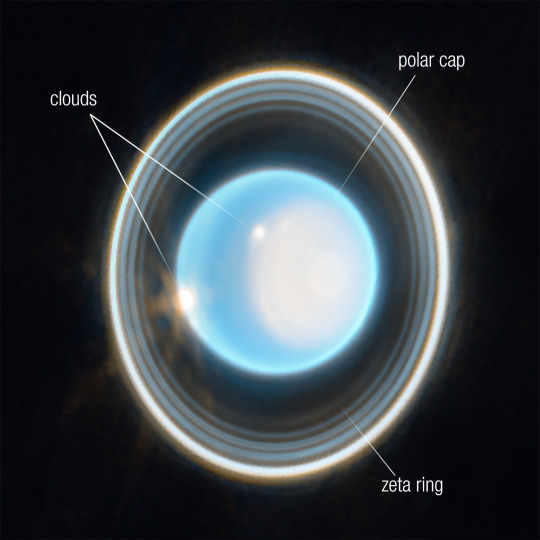
View On WordPress
#Ariane 5 rocket#Cosmic Microwave Background#Deep space observations#Exoplanets#Fine Guidance Sensor/Near InfraRed Imager and Slitless Spectrograph (FGS/NIRISS)#Galaxy formation#Hubble Space Telescope successor#Infrared Astronomy#Infrared detectors#James Webb Space Telescope (JWST)#Launch#Mid-Infrared Instrument (MIRI)#Mirror segments#Multi-object spectroscopy#NASA#Near InfraRed Spectrograph (NIRSpec)#Near-Infrared Camera (NIRCam)#Space telescope#Stellar populations#Sunshield#Transiting exoplanets#Universe formation and evolution#Webb Science Operations Center (JSOC)
0 notes
Text
Webb Telescope's Discovery: Distant Organic Molecules and the Einstein Ring Phenomenon
Einstein Ring Phenomenon
Introduction:
NASA’s James Webb Space Telescope has made a groundbreaking discovery by detecting complex organic molecules in a galaxy located over 12 billion light-years away from Earth. This remarkable finding sets a new record for the most distant detection of these intricate molecules, bearing resemblance to smoke or smog. Moreover, the telescope’s observation of an Einstein ring, caused by…

View On WordPress
#Ariane 5 rocket#Cosmic Microwave Background#Deep space observations#Exoplanets#Fine Guidance Sensor/Near InfraRed Imager and Slitless Spectrograph (FGS/NIRISS)#Galaxy formation#Hubble Space Telescope successor#Infrared Astronomy#Infrared detectors#James Webb Space Telescope (JWST)#Launch#Mid-Infrared Instrument (MIRI)#Mirror segments#Multi-object spectroscopy#NASA#Near-Infrared Camera (NIRCam)#Near-Infrared Spectrograph (NIRSpec)#Space telescope#Stellar populations#Sunshield#Transiting exoplanets#Universe formation and evolution#Webb Science Operations Center (JSOC)
0 notes
Text
The Quest for Habitable Worlds Beyond Our Solar System
Planets-Like-Earth
This is an artist’s impression of innumerable Earth-like planets that have yet to be born over the next trillion years in the evolving universe.
Credits: NASA, ESA, and G. Bacon (STScI)
The search for planets like Earth, often referred to as “exoplanets,” has ignited a profound sense of wonder and curiosity among astronomers and the general public alike. In recent years, incredible advancements…
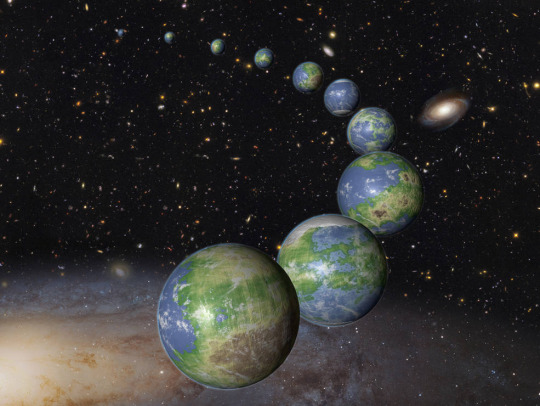
View On WordPress
#Astrobiology#AstronomicalCatalogs#AstronomicalDatabases#AstronomicalImaging#AstronomicalInstruments#AstronomicalObservations#AstronomicalPhenomena#AstronomicalSpectroscopy#AstronomicalSurveys#AstronomicalUnits#BlackHoles#CelestialBodies#Constellations#CosmicMicrowaveBackground#Cosmology#DarkEnergy#DarkMatter#Exoplanets#Galaxies#LightYears#MeteorShowers#Nebulae#Planets#SolarSystem#SpaceExploration#Stars#StellarEvolution#Supernovae#Telescopes
0 notes
Text
Liquid Gold: Exploring the Presence of Water on Mars
Water On Mars
Introduction:
For centuries, the possibility of liquid water on Mars has captivated the imaginations of scientists and space enthusiasts alike. Recent discoveries and scientific investigations have revealed compelling evidence that water, a fundamental ingredient for life as we know it, does indeed exist on the Red Planet. In this article, we embark on a journey to explore the presence of water…
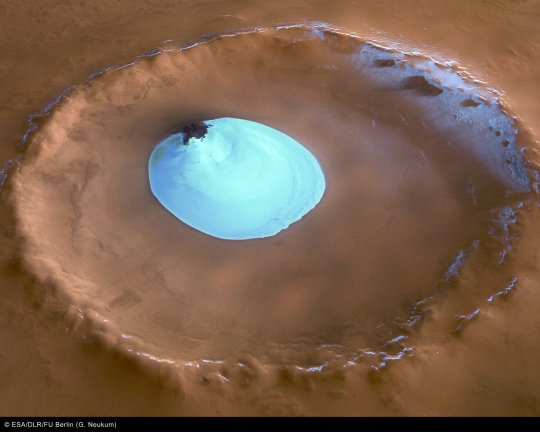
View On WordPress
#Astrobiology#Constellations#Cosmology#Galaxies#mars water#Planets#Solar System#Space Exploration#Stars#Telescopes
1 note
·
View note
Text
List of Apollo Moon Missions and Moonwalkers
Credit: NASA, ESA, CSA, and STScI
List of Apollo Moon Missions and Moonwalkers:
Apollo 11 (July 20, 1969):
Neil Armstrong
Edwin “Buzz” Aldrin
Apollo 12 (November 14-24, 1969):
Charles “Pete” Conrad Jr.
Alan L. Bean
Apollo 14 (February 5-9, 1971):
Alan B. Shepard Jr.
Edgar D. Mitchell
Apollo 15 (July 26-August 7, 1971):
David R. Scott
James B. Irwin
Apollo 16 (April 16-27,…
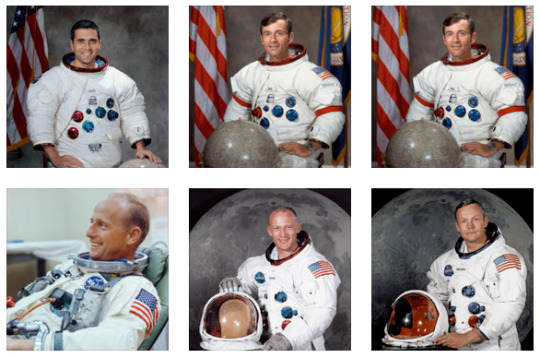
View On WordPress
#AstronomicalCatalogs#AstronomicalConstants.#AstronomicalDatabases#AstronomicalImaging#AstronomicalInstruments#AstronomicalObservations#AstronomicalPhenomena#AstronomicalSpectroscopy#AstronomicalSurveys#AstronomicalUnits#BlackHoles#CelestialBodies#CosmicMicrowaveBackground#DarkEnergy#DarkMatter#LightYears#MeteorShowers#SolarSystem#SpaceExploration#StellarEvolution#Astrobiology#Constellations#Cosmology#Exoplanets#Galaxies#moon landing#Nebulae#Planets#Stars#Supernovae
0 notes
Text
Debunking Moon Landing Conspiracy Theories: Separating Fact from Fiction
The notion that the moon landing was a hoax has persisted as a conspiracy theory for decades. However, it is essential to emphasize that these claims lack credible evidence and have been thoroughly debunked by experts and independent investigations. The overwhelming consensus among scientists, experts, and individuals involved in the missions is that the moon landings were indeed real.
Credit:…
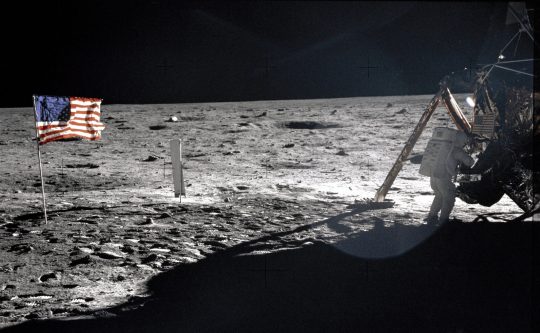
View On WordPress
#AstronomicalCatalogs#AstronomicalConstants.#AstronomicalDatabases#AstronomicalImaging#AstronomicalInstruments#AstronomicalObservations#AstronomicalPhenomena#AstronomicalSpectroscopy#AstronomicalSurveys#AstronomicalUnits#BlackHoles#CelestialBodies#CosmicMicrowaveBackground#DarkEnergy#DarkMatter#LightYears#MeteorShowers#SolarSystem#SpaceExploration#StellarEvolution#Astrobiology#Constellations#Cosmology#Exoplanets#Galaxies#moon landing#Nebulae#Planets#Stars#Supernovae
0 notes
Text
The Historic Moon Landing: A Giant Leap for Humankind
The moon landing stands as a monumental event, marking the historic occasion when humanity first set foot on the lunar surface. The most renowned moon landing occurred on July 20, 1969, as part of NASA’s Apollo 11 mission. American astronauts Neil Armstrong and Edwin “Buzz” Aldrin etched their names in history as the first and second individuals to walk on the moon, while astronaut Michael…

View On WordPress
#Astrobiology#AstronomicalCatalogs#AstronomicalConstants.#AstronomicalDatabases#AstronomicalImaging#AstronomicalInstruments#AstronomicalObservations#AstronomicalPhenomena#AstronomicalSpectroscopy#AstronomicalSurveys#AstronomicalUnits#BlackHoles#CelestialBodies#Constellations#CosmicMicrowaveBackground#Cosmology#DarkEnergy#DarkMatter#Exoplanets#Galaxies#LightYears#MeteorShowers#Nebulae#Planets#SolarSystem#SpaceExploration#Stars#StellarEvolution#Supernovae#Telescopes
0 notes
Text
Webb's Spectacular View: Zooming in on Uranus' Rings and Polar Cap
Prepare to be captivated by this stunning, zoomed-in image of Uranus, meticulously captured by Webb’s Near-Infrared Camera (NIRCam) on February 6, 2023. The image unveils a mesmerizing display of Uranus’ majestic rings. In this representative-color image, the planet shines with a striking blue hue, a result of combining data from two filters (F140M, F300M) at 1.4 and 3.0 microns. The blue and…

View On WordPress
#Astrobiology#AstronomicalCatalogs#AstronomicalDatabases#AstronomicalImaging#AstronomicalInstruments#AstronomicalObservations#AstronomicalPhenomena#AstronomicalSpectroscopy#AstronomicalSurveys#AstronomicalUnits#BlackHoles#CelestialBodies#Constellations#CosmicMicrowaveBackground#Cosmology#DarkEnergy#DarkMatter#Exoplanets#Galaxies#JamesWebbSpaceTelescope#JWST#LightYears#MeteorShowers#Nebulae#Planets#SolarSystem#SpaceExploration#Stars#StellarEvolution#Supernovae
0 notes
Text
Insights from the First Observations: Unveiling the Hubble Ultra Deep Field with Webb
Hubble Ultra Deep Field with Webb
We had the opportunity to interview Christina Williams from NSF’s NOIRLab, Sandro Tacchella from the University of Cambridge, and Michael Maseda from the University of Wisconsin-Madison to gain insights into the first observations of the Hubble Ultra Deep Field through the eyes of the Webb telescope.
Credit: NASA, ESA, CSA, STScI, C. Williams (NSF’s NOIRLab), S. Tacchella (Cambridge), Michael…

View On WordPress
#AstronomicalObservations#AstronomicalPhenomena#Astrobiology#Astronomical Catalogs#Astronomical Databases#Astronomical Imaging#Astronomical Instruments#Astronomical Spectroscopy#Astronomical Surveys#Astronomical Units#Celestial Bodies#Constellations#Cosmic Microwave Background#Cosmology#Dark Energy#Dark Matter#Galaxies#Light-years#Meteor Showers#Solar System#Space Exploration#Stars#Stellar Evolution#Telescopes
1 note
·
View note
Text
Unveiling the Celestial Eye: Exploring the Helix Nebula (NGC 7293)
Helix Nebula (NGC 7293)
Among the mesmerizing wonders of the cosmos, the Helix Nebula, also known as NGC 7293, stands out as a celestial spectacle that has captured the imagination of astronomers and stargazers alike. Residing in the constellation Aquarius, this magnificent nebula showcases intricate structures reminiscent of a cosmic eye. In this article, we embark on a journey to explore the Helix Nebula, uncovering…
View On WordPress
#Astrobiology#Astronomical Catalogs#Astronomical Databases#Astronomical Imaging#Astronomical Instruments#Astronomical Observations#Astronomical Phenomena#Astronomical Spectroscopy#Astronomical Surveys#Astronomical Units#Black Holes#Celestial Bodies#Constellations#Cosmic Microwave Background#Cosmology#Dark Energy#Dark Matter#Exoplanets#Galaxies#Light-years#Meteor Showers#Nebulae#Planets#Solar System#Space Exploration#Stars#Stellar Evolution#Supernovae#Telescopes
1 note
·
View note
Text
The Ring Nebula (M57): A Cosmic Jewel in the Sky
Among the celestial treasures scattered throughout the vast expanse of the universe, the Ring Nebula, also known as Messier 57 (M57), stands out as a captivating jewel adorning the night sky. Residing in the constellation Lyra, this stunning nebula has fascinated astronomers and stargazers for centuries. In this article, we embark on an exploration of the Ring Nebula, uncovering its origins,…
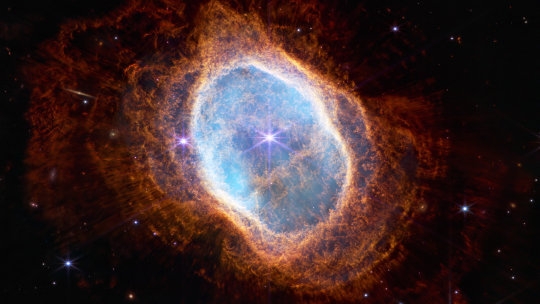
View On WordPress
#Astrobiology#Astronomical Catalogs#Astronomical Databases#Astronomical Imaging#Astronomical Instruments#Astronomical Observations#Astronomical Phenomena#Astronomical Spectroscopy#Astronomical Surveys#Astronomical Units#Black Holes#Celestial Bodies#Constellations#Cosmic Microwave Background#Cosmology#Dark Energy#Dark Matter#Exoplanets#Galaxies#Light-years#Meteor Showers#Nebulae#Planets#Solar System#Space Exploration#Stars#Stellar Evolution#Supernovae#Telescopes
5 notes
·
View notes
Text
Unveiling the Cosmic Remnant: Exploring the Crab Nebula (M1)
Credits: NASA, ESA, J. Hester and A. Loll (Arizona State University)
Among the fascinating remnants of stellar explosions, the Crab Nebula, also known as Messier 1 (M1), stands as a testament to the immense forces that shape our universe. Located in the constellation Taurus, this celestial spectacle has captivated astronomers and enthusiasts alike for centuries. In this article, we embark on a…

View On WordPress
#Astrobiology#Astronomical Catalogs#Astronomical Databases#Astronomical Imaging#Astronomical Instruments#Astronomical Observations#Astronomical Phenomena#Astronomical Spectroscopy#Astronomical Surveys#Astronomical Units#Black Holes#Celestial Bodies#Constellations#Cosmic Microwave Background#Cosmology#Dark Energy#Dark Matter#Exoplanets#Galaxies#Light-years#Meteor Showers#Nebulae#Planets#Solar System#Space Exploration#Stars#Stellar Evolution#Supernovae#Telescopes
6 notes
·
View notes
Text
The Majestic Eagle Nebula (M16): Unveiling the Stellar Sculptor
Credit: NASA, ESA, and the Hubble Heritage Team (STScI/AURA)
In the depths of the cosmos lies a breathtaking celestial masterpiece known as the Eagle Nebula, or Messier 16 (M16). Located in the constellation Serpens, this nebula has captivated astronomers and stargazers with its stunning beauty and unique features. In this article, we will embark on a journey to explore the enigmatic Eagle…

View On WordPress
#Astrobiology#Astronomical Catalogs#Astronomical Databases#Astronomical Imaging#Astronomical Instruments#Astronomical Observations#Astronomical Phenomena#Astronomical Spectroscopy#Astronomical Surveys#Astronomical Units#Black Holes#Celestial Bodies#Constellations#Cosmic Microwave Background#Cosmology#Dark Energy#Dark Matter#Exoplanets#Galaxies#Light-years#Meteor Showers#Nebulae#Planets#Solar System#Space Exploration#Stars#Stellar Evolution#Supernovae#Telescopes
6 notes
·
View notes